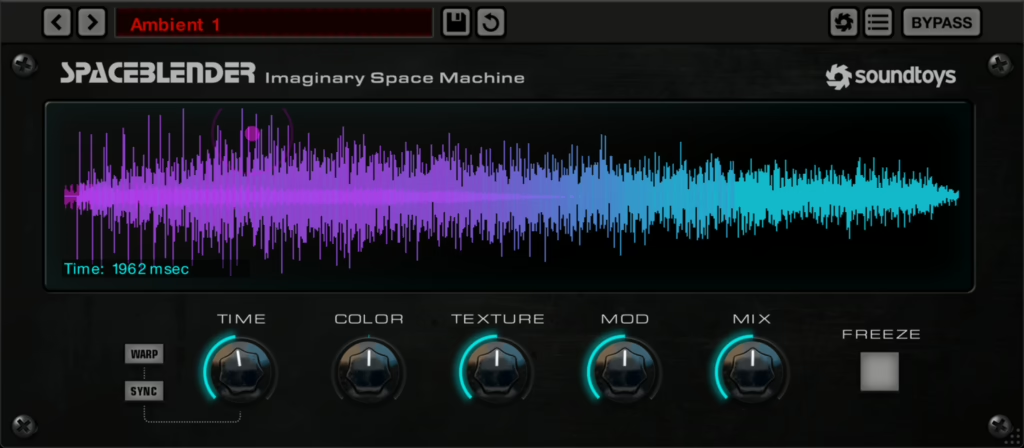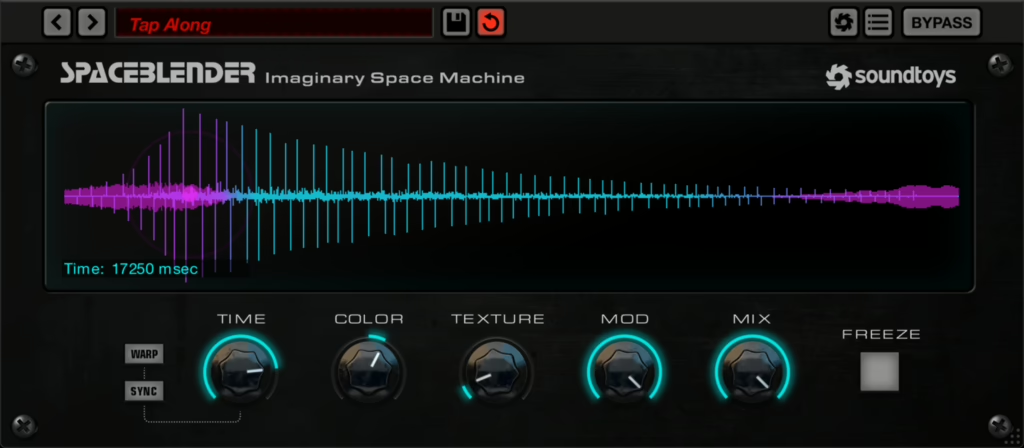REVIEW: Soundtoys SpaceBlender
Beloved Vermont-based plugin developer takes reverb (and sound design) to far off, previously unimagined places.
by Paul French

Get mutech updates in your inbox
One of my most vivid memories of this year’s NAMM Expo (amongst a slew of not-so-vivid memories), was a cloak and dagger, partial reveal of a Beta version of a then top secret plugin by beloved Vermont based software developer, Soundtoys.
Now, I have little doubt that these lasting impressions were aided somewhat by the Soundtoys exhibits proximity to the bar, but I have very clear memories of walking past multiple times over the course of my three days at the convention and each time being legitimately impressed by what I was hearing, both in the musicality and taste of the performers, but also by the ‘otherworldly’ (for want of a better term) textures being produced by this mysterious plugin.
Best described as a granular, ambient reverb the likes of which felt steeped in the sonic lineage of other Soundtoys plugins like Crystalliser, Little Alter Boy and PhaseMistress, (but with a feeling and responsiveness that was all its own), the plugin (still in its Beta stages of testing) sounded like a genuinely new approach to the long release ambient sounds we have grown accustomed to in the genre. Sure there was a bit of Eno and Yoshimura in there, but the sonic palette on offer exuded something more forward thinking. More weirdness, more fuckery (but still musical in a way which so many other ‘experimental’ effects often fall short).
Fast forward five months and hours and hours of testing and refining and Soundtoys have finally unveiled their baby to the masses, giving it the trippy/meta title of SpaceBlender (because how do you like…. Blend Space, man?) and contributing something truly unique and progressive to an already highly saturated plugin market.
Described as an algorithmic reverb (not to mention, one that often gleefully subverts and eschews the kinds of conventional feedback delay/convolution networks we’ve become accustomed to in the world of time based effects), the SpaceBlender’s unique swarm algorithm allows the user to dynamically control the reverb shape and in turn, achieve sounds that would make conventional reverbs unstable. The result is both fresh and captivating with limitless potential across multiple sound sources and applications.
True to form, Soundtoys have always been one of the best in the business when it comes to providing a simple visual representation of a complex audio theory and SoundBlender continues to carry the torch passed on from OG SoundToys plugins like Echoboy and FilterFreak.
The dual purpose ‘Visualiser’ in this case is both a display to monitor the reverb’s shape and duration but also a place for further tweaking and manipulation, allowing users to grab and shape the reverb’s response via an easy to navigate and aesthetically pleasing interface and cursor control. This is particularly useful when we take into consideration the importance of time (and its visual representation) within the context of a reverb plugin and the tendency for musicians to be anything but numbers people.
Without getting all rambly, incoherent, ambient DX7 concept album about a fish on a jetty with you, it’s also pretty interesting to note how for a product with a name like ‘SpaceBlender’, Soundtoys have left no stone unturned when it comes to the ‘Time’ functionality of this very conceptual plugin. Almost like ‘time’ and ‘space’ share an intrinsic cosmic connection, but I digress.
Offering an extreme range from super short 100-millisecond nonlinear effects to absurdly long 60-second meditations/permutations, the SpaceBlender is sure to provide something weird and wonderful for any composition or sound source, with an obscene amount of tweakability and experimentation to be had within this one parameter alone.

Where things get particularly interesting is in the ‘warp’ and ‘sync’ functions, which are two of the primary features that separate SpaceBlender from your average reverb plugin. The ‘warp’ function works as a kind of pitchshifter/tape speed dial for manipulating our reverberant audio (often in an analogously chromatic fashion), while the Sync function is the designated driver in this scenario, ensuring that things get home in one piece, directly on curfew (and with their musicality still intact.)
There are even shortcuts within the Time function. A simple Shift click allows for finer control within the parameter, perfect for fine tuning the reverb for more conservative applications, like providing subtle differentiation and definition across individually miced drums or to split up multi miced guitar sources etc.
The ‘Density’ parameter is something akin to a ‘diffusion’ setting (albeit within the context of swarm algorithms) and is something this plugin does particularly well. The lushness and genuine sense of space afforded by manipulating the density knob is a testament to the quality of the audio engine of this particular plugin. Suffice to say that no matter how dense and cacophonous things get, they never, if ever, bear the traditional tells of cheap digital reverb, rather the swarm algorithms and nuanced networks only feel lusher and denser, the more extremely they are applied. After all, this is Ambient, not Noise we are talking about here.
If one was in a noisier frame of mind, the ‘Freeze’ function would no doubt provide you with plenty of scope for brutality. Serving as something of an infinite loop reverb function, the ‘Freeze’ parameter is ideal for taking things dystopian, particularly when used in conjunction with the ‘Mod’ and ‘Warp’ parameters or sandwiched between various other heavy handed plugins in the insert chain from hell.
This is perhaps one of the SpaceBlenders biggest strengths and in my opinion, where it gets it so right. Sure it can be applied lightly and in a traditional manner, but on the more extreme end, it has the capacity to not just go to 11, but all the way up to 20-in turn taking your source beyond its standard sonic envelope and into somewhere truly progressive.
Now for those of you playing at home, you may notice that I keep stressing words like ‘progressive’, ‘unique’ and ‘fresh’ when speaking about this plugin, and that’s for good reason. The purpose of this reverb is not so much in its ability to mimic the pre-existing, natural world, but rather in its innate knack for taking familiar sound sources and reimagining them into something artfully unrecognisable.
If eras in production are typified by happy studio anomalies-accidentally gating the reverb on a talkback mic here, bumping the parameters on an Autotune insert there, then the SpaceBlender is precisely the kind of tool that streamlines this kind of discovery. Merely tweaking the knobs for a few seconds with no rhyme or reason can drastically alter an instrument’s character or purpose within the context of an arrangement, bringing peripheral elements to the fore and obfuscating prime candidates.
While most plugins tend to be an attempt to replicate a pre-existing sound on the cheap (and often falling short), this one guarantees something completely new and exciting and not yet heard and that alone is worthy of the cost of entry, even just as a roll of the dice for when you’ve painted yourself into a corner or for when the standard formulas have become formulaic.
In those situations, the SpaceBlender will no doubt loosen up the tie a bit, providing you with something weird, wonderful and (potentially) wevolutionary [sic].